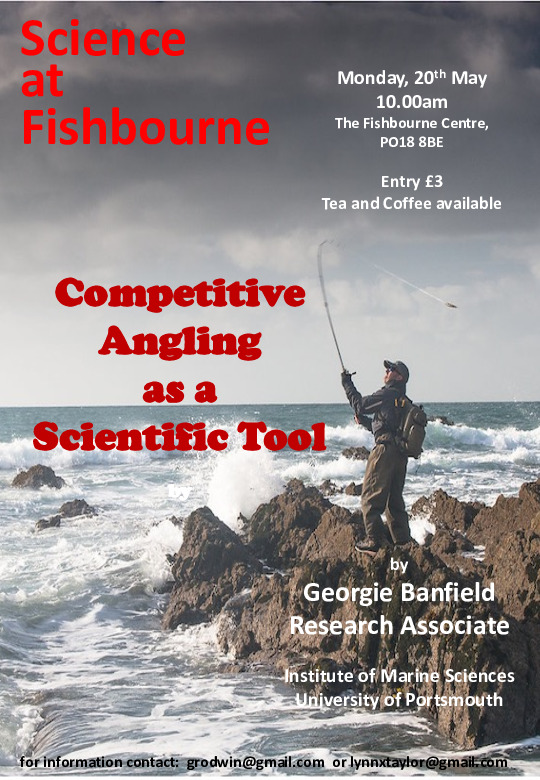
Lynn’s Review
The waters of the Solent are of great interest to us, as this is our local area, and Georgina Banfield, from Portsmouth University presented an excellent insight into a new project, funded by DEFRA. It began in April 2023 and ends next year.
After hearing about the scope of this project, we hope that the seeds sown will lead to continued research.
When Brexit occurred, fisheries around Britain were left without rules, so in 2020, “The Fisheries Management Act,” was brought into legislation. It has 3 themes:
- Sustainable fishing;
- Social and Economic;
- and Evidence from data collected.
Of the 43 proposed plans, only 5 have been written. Some fish, such as Sea Bass and Sea Bream, have individual plans and others, such as Rays and Skates are combined.
Sea Bass, is shown to be vulnerable, with the lowest stock in 20 years recorded. There are not enough young fish growing up.
The project, run by Portsmouth University, highlights ecosystem management and connectivity in the Solent. This is not covered by standard stock assessments. Fish move; they may reproduce in one area and move to other areas as they develop.
There are financial costs of undertaking such a project, and so innovation is required. This has come in the form of engaging Sea Anglers through an annual competition.
The Southern Inshore Fisheries and Conservation Authority support, “Angling Spirit,” an organisation who, amongst other things, organise fishing competitions. The “Sea Angling Classic Competition,” takes place in June. Sixty boats depart from Port Solent for a two-day fishing trip and the prize table runs to £200,000.
The rules of the competition are set to help advance the data needed to support sustainable fishing. The fish to catch are Bass, Bream, Rays, Smooth-hound and Tope. This range of fish was chosen as different fishing tactics are needed for each kind. This is fun for fishermen, and also helps with data on many elements such as: location, depth and frequency, of each fish type, some of which are endangered.
The fishermen must identify their fish; photograph them; log their length and release them correctly. Prizes are given for the longest cumulative length of the fish caught.
Such a means of research, called Citizen Science, is currently being used widely. It requires careful instructions and checking; it’s an evolving method, and this is something the team at Portsmouth University are addressing in their project. They hope to set out a guide for future investigations around the UK and beyond.
Boats taking part in the fishing competition have GPS trackers and GoPro cameras. These devices can ensure that they are fishing in the correct areas, in the correct way. The GPS also helps to determine how many fish are caught per hour, per rod in each location, so highlighting fish density in each area.
The sea angling competition has been running for three years in the Solent, and data shows that smooth-hounds are caught the most, while bass only make up a small percentage of fish caught. This, of course, raises questions, and highlights the adjustments needed as a project progresses. As questions arise, solutions are sought to improve the methods of collecting and interpreting data. For example: smooth-hounds might just be easier to catch than bass.
Other issues, concern fish identification: When is a skate not a skate, but a ray? Is it a tope or a smooth-hound? Is the fish male or female? The Portsmouth team will address each of these areas with clearer identification charts, photographs from different angles and AI programmes to help with clear length measurement of fish that don’t keep still on a ruler.
DNA analysis is also used, although difficulties with contamination from other fish; surfaces on the boat; and fishermen, make this more difficult. DNA sampling of water; environmental DNA, is more successful as this method can show all fish species that have moved through that location.
The ultimate goal for fish identification, is being investigated by Portsmouth University’s Institute of Cosmology and Gravitation. They hope to make it possible to identify specific fish with a smart phone.
Artificial Intelligence works by viewing many photos of fish in order to label them. Citizen science asks for your help with this. Clear photos of fish caught are sought from fishermen.
It is also intended that AI should determine whether a fish has been caught before, so avoiding counting the same fish more than once. Individual fish recognition!
Other investigations are being carried out using sonar and drop-down videos to map the sea floor and assess the depth and structural complexity of various habitats. Also baited remote underwater videos are used to record the fish that come to eat the bait.
Although the government funding for this project comes to an end next year, the Sea Angling Classic competition will continue. The intention is to expand the programme to take it to other areas around the coast.
The links below give more information.
I found these interesting snippets of information amongst the links.
There are 2 types of projects funded directly by fishing licence income. They are: Angling Improvement Fund projects managed by the Angling Trust through the National Angling Strategic Services contract. Fisheries Improvements Programme projects managed by local Environment Agency teams. The Sea Angling Classic received some of these funds.
Fisheries Report:
During the financial year 1 April 2022 to 31 March 2023 we sold 903,216 fishing licences. This generated an income of £20,900,000. We also received £1,400,000 grant in aid from central government.
https://defrafmp.blog.gov.uk/2024/05/14/where-we-are-now-with-fmps/